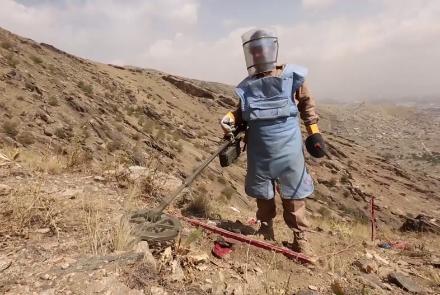Afghanistan’s people are world’s second worst-hit victims of landmines and unexploded ordinance after the people of Yemen, a report by the organization Landmines Monitor has shown.
According to Landmine Monitor 2017, the armed conflicts in Afghanistan, Libya, Ukraine, and Yemen contributed to the second year of exceptionally high casualties caused by mines, including improvised devices that are triggered like mines, and other explosive remnants of war.
The report was released this week and was presented by Afghan officials at a press conference on Thursday.
The report indicates that from October 2016 to October 2017, non-state armed groups used antipersonnel mines, including improvised mines, in at least nine countries: Afghanistan, India, Iraq, Myanmar, Nigeria, Pakistan, Syria, Ukraine, and Yemen.
According to the report at least 100 people lose their lives in mines and unexploded ordnance explosions every month in Afghanistan. A further at least 2,000 people were maimed as a result of mine and other explosives the country.
“Afghanistan has the highest number of victims compared the last year, but this year Yemen too had a high number of victims. The casualties have increased to 1,943 people this year from 1,310 last year,” said Islamuddin Mohammadi, head of Afghans Affected by Mines Organization.
According to the report, the ongoing war in the country has increased the threats from landmines and unexploded ordnance.
“The de-mining program in Afghanistan has so far defused at least 800,000 antipersonnel mines and almost 30,000 antivehicle mines,” said Abdul Waheed Lewal, head of a demining organization in Kabul.
A bomb victim, Amina Azami, says she lost her leg when she was nine in a roadside explosion.
“When my leg was chopped off, I was in bed for one and a half years because my both legs were injured in the explosion,” she said.
The report shows that for 2016, the Monitor recorded 8,605 mine/ERW casualties, of which at least 2,089 people were killed.
Following a sharp increase in 2015, the casualty total in 2016 marked the highest number of annually recorded casualties in Monitor data since 1999 (9,228). This included the most child casualties ever recorded, and the highest number of annual casualties caused by improvised mines. Despite being weapons of war, mines/ERW mostly kill and injure civilians, who made up 78% of all recorded casualties in 2016, similar to past years.
The report says that in 2016 international donors increased their support for mine action, an umbrella term that includes clearance, victim assistance, risk education, stockpile destruction, monitoring, and advocacy.
Thirty-two donors contributed US$479.5 million for anti-mine action in 40 states and three other areas, an increase of $85.5 million from 2015. With contributions by affected states to their own national programs totaling $85.0 million, global contributions to anti-mine action amounted to approximately $564.5 million, an increase of nearly $40 million compared to 2015.
In 2016, countries continued the labor-intensive work to make previously mined areas safe for use, reporting about 170 km2 of land cleared of landmines—a level similar to 2015—and the destruction of more than 232,000 landmines—a significant increase compared to 2015. In 2017, Algeria and Mozambique declared themselves free of landmines.
Among the 61 countries and other sovereignty-disputed areas that are known to have mine contamination. Of them, 33 are States Parties to the Mine Ban Treaty, which calls for clearance of known contamination within 10 years.
Only four of those appear to be on track to meet their deadlines: Chile, the Democratic Republic of the Congo, Mauritania, and Peru, the report adds.
Click here to read full report.


